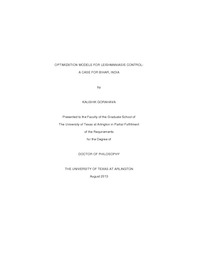
ATTENTION: The works hosted here are being migrated to a new repository that will consolidate resources, improve discoverability, and better show UTA's research impact on the global community. We will update authors as the migration progresses. Please see MavMatrix for more information.
Show simple item record
| dc.contributor.author | Gorahava, Kaushik | en_US |
| dc.date.accessioned | 2013-10-22T23:59:13Z | |
| dc.date.available | 2013-10-22T23:59:13Z | |
| dc.date.issued | 2013-10-22 | |
| dc.date.submitted | January 2013 | en_US |
| dc.identifier.other | DISS-12317 | en_US |
| dc.identifier.uri | http://hdl.handle.net/10106/23917 | |
| dc.description.abstract | Leishmaniasis, is a family of infectious diseases, which mostly affects poor and developing countries. The highest prevalence and mortality rate of Visceral Leishmaniasis (VL) the world over occurs in Bihar state of India. Many disease control methods are available; however, procedures aimed at reducing sandfly population by spraying insecticide have been the most effective for controlling VL in Bihar. In this dissertation, optimization models for the control of Leishmaniasis are developed and analyzed. Novel optimization models are built and analyzed to identify the optimal amount of insecticide allocated for controlling the spread of VL in Bihar. Since the vector (disease transmitting insects) Phlebotomus Argentipes, responsible for the spread of this disease, are zoophilic in nature, the implication from this research study recommends schematic allocation of insecticide based on both human and cattle populations. Six models were developed for analyzing insecticide intervention to control the spread of VL in Bihar. All model formulations were calibrated using estimates of entomological, insecticide toxicity, demographical and budget related parameters from appropriate literature sources. A mathematical model for comparing the options of spraying insecticide in preplanned number of sites (houses and cattle sheds) was developed. An existing model of VL transmission dynamics in Bihar state was revised to include the effects of insecticide intervention. The two main optimization models developed were: linear and nonlinear. The linear optimization model recommends optimal insecticide allocation amount between the two types of sites. This model optimizes sandfly mortality using limited financial resources available to the public health department. The nonlinear optimization model optimizes the number of humans saved from infection. Results from the optimization models were analyzed to study the impact of considering state and district level demographic data on number of human infections saved. A qualitative analysis of the comparison of the four optimization models was performed to recommend best insecticide spray campaign policy. | en_US |
| dc.description.sponsorship | Rosenberger, Jay M. | en_US |
| dc.language.iso | en | en_US |
| dc.publisher | Industrial & Manufacturing Engineering | en_US |
| dc.title | Optimization Models For Leishmaniasis Control: A Case For Bihar, India | en_US |
| dc.type | Ph.D. | en_US |
| dc.contributor.committeeChair | Rosenberger, Jay M. | en_US |
| dc.degree.department | Industrial & Manufacturing Engineering | en_US |
| dc.degree.discipline | Industrial & Manufacturing Engineering | en_US |
| dc.degree.grantor | University of Texas at Arlington | en_US |
| dc.degree.level | doctoral | en_US |
| dc.degree.name | Ph.D. | en_US |
Files in this item
- Name:
- Gorahava_uta_2502D_12317.pdf
- Size:
- 1.531Mb
- Format:
- PDF
This item appears in the following Collection(s)
Show simple item record


